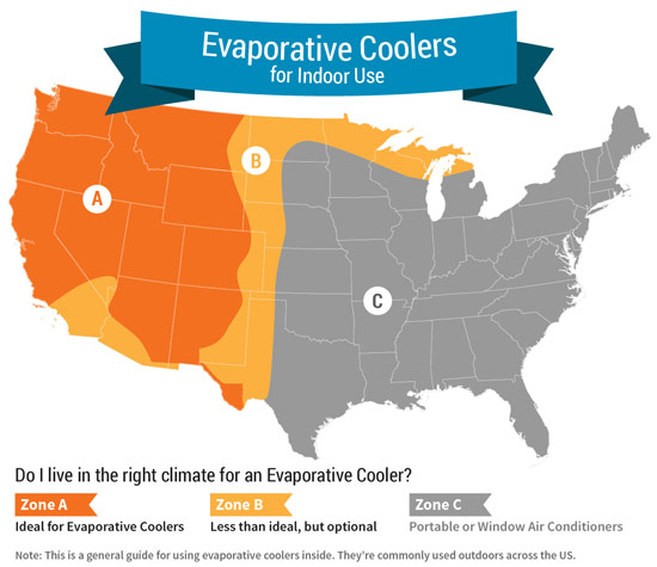 Although the name “swamp cooler” sounds like it would cool muggy, swamp-like conditions, these machines would actually be ineffective in warm, humid areas like the southeastern United States because the air is so heavily saturated with moisture.
Evaporative coolers tend to work best when relative humidity is 60% or less; however, evaporative coolers can work in humid conditions when they are used in semi-outdoor (loading bays and docks, garages) and outdoor conditions (sporting events, festivals) for moisture evaporation.
Because of the potential for moisture build-up indoors, an open window or door is required for use and not recommended for indoor use in humid climates. For people living in more humid climates who are searching for a cost-effective alternative to traditional central air conditioning systems, consider portable air conditioners or window air conditioners.
Although the name “swamp cooler” sounds like it would cool muggy, swamp-like conditions, these machines would actually be ineffective in warm, humid areas like the southeastern United States because the air is so heavily saturated with moisture.
Evaporative coolers tend to work best when relative humidity is 60% or less; however, evaporative coolers can work in humid conditions when they are used in semi-outdoor (loading bays and docks, garages) and outdoor conditions (sporting events, festivals) for moisture evaporation.
Because of the potential for moisture build-up indoors, an open window or door is required for use and not recommended for indoor use in humid climates. For people living in more humid climates who are searching for a cost-effective alternative to traditional central air conditioning systems, consider portable air conditioners or window air conditioners.
How do swamp coolers compare with traditional air conditioning systems in terms of cost-effectiveness, energy-efficiency, and environmental impact?
The goal of both of swamp coolers and traditional ACs is to cool your space. However, swamp coolers are available at a lower overall price point, are more energy efficient, and are much more environmentally friendly than traditional air conditioning systems. Evaporative air coolers come in a variety of designs and capacities – evaporative coolers by brands like Hessaire, Whirlpool and Honeywell can easily be moved from room-to-room, or sit them outside on patios, decks, or pavilions. Further, brands like Portacool offer efficient swamp coolers for industrial spaces like barns, auto garages, hangars, docks, warehouses, and more. More importantly, many swamp coolers require only minor to moderate setup, such as placement of air filters or window mounting.- Energy-Efficiency: The use of simple technology to cool your indoor air helps portable air coolers excel at energy-efficiency. Compared to air conditioners that use compressors and refrigerants, swamp coolers use only water, a fan, and pump to saturate the cooling media to create cool air.
- Cost-Effective: A 36-inch evaporative air cooler operating for eight hours typically costs less than one dollar because the only costs associated with operating it are water and electricity. This is almost three times cheaper than traditional cooling costs, as operating swamp coolers costs up to 50 percent less.
- Environmentally-Friendly: For environmentally-conscious consumers, swamp coolers are an ideal solution for keeping cool without harming the environment. Unlike traditional air conditioners that use refrigerants to cool your home, swamp coolers use a natural process that cools the air using motion and water. This process won’t add ozone-harming pollutants or other chemicals to the environment.



